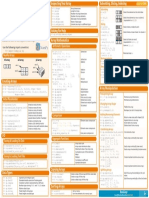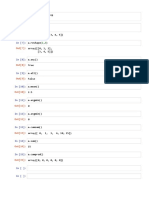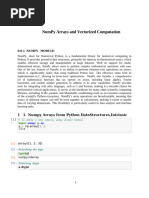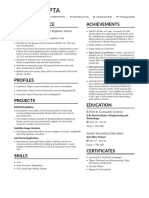Numpy Session1
Uploaded by
jeevangowda2709Numpy Session1
Uploaded by
jeevangowda2709Packages
1.Numpy 2.Scipy 3.Pandas 4.Matplotlib
NUMPY Advantages of arrays
1.Less memory 2.Fast 3.Convinient
In [1]:
import sys
import numpy as np
l=range(1000)
print(sys.getsizeof(5)*len(l))
array=np.arange(1000)
print(array.size*array.itemsize)
28000
4000
In [4]:
import time
SIZE=10000000
l1=range(SIZE)
l2=range(SIZE)
a1=np.array(SIZE)
a2=np.array(SIZE)
start=time.time()
result = [(x+y) for x,y in zip(l1,l2)]
print("python list time:", (time.time()-start)*1000)
start=time.time()
result=a1+a2
print("numpy time:", (time.time()-start)*1000)
python list time: 1460.3404998779297
numpy time: 127.62713432312012
In [5]:
import numpy as np
a=np.array([1,2,3,4,5])
a
Out[5]: array([1, 2, 3, 4, 5])
In [ ]:
a=np.array([[[1,2,3],[4,5,6],[7,8,9]]])
In [6]:
l=[1,2,3,4,5]
b=[a+1 for a in l]
b
Out[6]: [2, 3, 4, 5, 6]
In [9]:
import numpy as np
l=np.array(l)
b=l+1
b
Out[9]: array([2, 3, 4, 5, 6])
In [16]:
a=np.array([[1,2],[3,4]])
b=np.array([[7,8],[9,10]])
a.dot(b)
Out[16]: array([[25, 28],
[57, 64]])
In [29]:
a=np.array([[1,2],[3,4],[5,6]])
a.ndim
Out[29]: 2
In [30]:
a.itemsize
Out[30]: 4
In [31]:
a.dtype
Out[31]: dtype('int32')
In [32]:
a
Out[32]: array([[1, 2],
[3, 4],
[5, 6]])
In [33]:
a.size
Out[33]: 6
In [34]:
a.shape
Out[34]: (3, 2)
In [35]:
np.zeros((3,4))
Out[35]: array([[0., 0., 0., 0.],
[0., 0., 0., 0.],
[0., 0., 0., 0.]])
In [36]:
np.ones((3,4))
Out[36]: array([[1., 1., 1., 1.],
[1., 1., 1., 1.],
[1., 1., 1., 1.]])
In [37]:
a.shape
Out[37]: (3, 2)
In [38]:
a.reshape(2,3)
Out[38]: array([[1, 2, 3],
[4, 5, 6]])
In [41]:
np.arange(1,5,2)
Out[41]: array([1, 3])
In [42]:
a
Out[42]: array([[1, 2],
[3, 4],
[5, 6]])
In [45]:
a.ravel()
a
Out[45]: array([[1, 2],
[3, 4],
[5, 6]])
In [46]:
np.linspace(1,5,10)
Out[46]: array([1. , 1.44444444, 1.88888889, 2.33333333, 2.77777778,
3.22222222, 3.66666667, 4.11111111, 4.55555556, 5. ])
In [47]:
a
Out[47]: array([[1, 2],
[3, 4],
[5, 6]])
In [49]:
a.min()
Out[49]: 1
In [50]:
a.max()
Out[50]: 6
In [53]:
a.sum(axis=1)
Out[53]: array([ 3, 7, 11])
In [54]:
np.sqrt(a)
Out[54]: array([[1. , 1.41421356],
[1.73205081, 2. ],
[2.23606798, 2.44948974]])
In [55]:
np.std(a)
Out[55]: 1.707825127659933
In [2]:
l=[1,2,3,4,5]
l[0:3]
Out[2]: [1, 2, 3]
In [3]:
import numpy as np
a=np.array([1,2,3,4])
a[0:2]
Out[3]: array([1, 2])
In [16]:
a=np.array([[[1,2,3],[4,5,6],[7,8,9]],[[10,11,12],[13,14,15],[16,17,18]]])
a[0:2,2,0:2]
Out[16]: array([[ 7, 8],
[16, 17]])
In [10]:
Out[10]: array([[2, 3],
[5, 6]])
In [18]:
a=np.array([[1,2,3],[4,5,6],[7,8,9]])
1
2
3
4
5
6
7
8
9
In [23]:
a=np.arange(6).reshape(3,2)
b=np.arange(6,12).reshape(3,2)
print(a)
print(b)
[[0 1]
[2 3]
[4 5]]
[[ 6 7]
[ 8 9]
[10 11]]
In [25]:
np.hstack((a,b))
Out[25]: array([[ 0, 1, 6, 7],
[ 2, 3, 8, 9],
[ 4, 5, 10, 11]])
In [26]:
np.vstack((a,b))
Out[26]: array([[ 0, 1],
[ 2, 3],
[ 4, 5],
[ 6, 7],
[ 8, 9],
[10, 11]])
In [28]:
a=np.arange(30).reshape(2,15)
a
Out[28]: array([[ 0, 1, 2, 3, 4, 5, 6, 7, 8, 9, 10, 11, 12, 13, 14],
[15, 16, 17, 18, 19, 20, 21, 22, 23, 24, 25, 26, 27, 28, 29]])
In [33]:
result=np.hsplit(a,3)
result[0]
Out[33]: array([[ 0, 1, 2, 3, 4],
[15, 16, 17, 18, 19]])
In [32]:
np.vsplit(a,2)
Out[32]: [array([[ 0, 1, 2, 3, 4, 5, 6, 7, 8, 9, 10, 11, 12, 13, 14]]),
array([[15, 16, 17, 18, 19, 20, 21, 22, 23, 24, 25, 26, 27, 28, 29]])]
In [34]:
a=np.arange(12).reshape(3,4)
a
Out[34]: array([[ 0, 1, 2, 3],
[ 4, 5, 6, 7],
[ 8, 9, 10, 11]])
In [35]:
b=a>4
b
Out[35]: array([[False, False, False, False],
[False, True, True, True],
[ True, True, True, True]])
In [36]:
a[b]
Out[36]: array([ 5, 6, 7, 8, 9, 10, 11])
nditer
In [38]:
a=np.arange(12).reshape(3,4)
print(a)
for x in np.nditer(a,order='C'):
print(x)
[[ 0 1 2 3]
[ 4 5 6 7]
[ 8 9 10 11]]
0
1
2
3
4
5
6
7
8
9
10
11
In [39]:
a=np.arange(12).reshape(3,4)
print(a)
for x in np.nditer(a,order='F'):
print(x)
[[ 0 1 2 3]
[ 4 5 6 7]
[ 8 9 10 11]]
0
4
8
1
5
9
2
6
10
3
7
11
In [40]:
for x in np.nditer(a, order='F',flags=['external_loop']):
print(x)
[0 4 8]
[1 5 9]
[ 2 6 10]
[ 3 7 11]
In [48]:
a=np.arange(12).reshape(3,4)
print(a)
for x in np.nditer(a,op_flags=['readwrite']):
x[...]=x*x
print(a)
[[ 0 1 2 3]
[ 4 5 6 7]
[ 8 9 10 11]]
[[ 0 1 4 9]
[ 16 25 36 49]
[ 64 81 100 121]]
In [50]:
import numpy as np
a=np.array([[[1,2,3],[4,5,6]],[[7,8,9],[10,11,12]]])
a[1,0:2,1]
Out[50]: array([ 8, 11])
Scipy
1.cluster
2.constants 3.fft pack 4.integrate
In [52]:
import scipy
from scipy import cluster
help()
Welcome to Python 3.8's help utility!
If this is your first time using Python, you should definitely check out
the tutorial on the Internet at https://docs.python.org/3.8/tutorial/.
Enter the name of any module, keyword, or topic to get help on writing
Python programs and using Python modules. To quit this help utility and
return to the interpreter, just type "quit".
To get a list of available modules, keywords, symbols, or topics, type
"modules", "keywords", "symbols", or "topics". Each module also comes
with a one-line summary of what it does; to list the modules whose name
or summary contain a given string such as "spam", type "modules spam".
help> scipy.cluster
Help on package scipy.cluster in scipy:
NAME
scipy.cluster
DESCRIPTION
=========================================
Clustering package (:mod:`scipy.cluster`)
=========================================
.. currentmodule:: scipy.cluster
:mod:`scipy.cluster.vq`
Clustering algorithms are useful in information theory, target detection,
communications, compression, and other areas. The `vq` module only
supports vector quantization and the k-means algorithms.
:mod:`scipy.cluster.hierarchy`
The `hierarchy` module provides functions for hierarchical and
agglomerative clustering. Its features include generating hierarchical
clusters from distance matrices,
calculating statistics on clusters, cutting linkages
to generate flat clusters, and visualizing clusters with dendrograms.
PACKAGE CONTENTS
_hierarchy
_optimal_leaf_ordering
_vq
hierarchy
setup
tests (package)
vq
DATA
__all__ = ['vq', 'hierarchy']
FILE
c:\users\pavankumar.muniswamy\anaconda3\lib\site-packages\scipy\cluster\__init__.py
help> quit
You are now leaving help and returning to the Python interpreter.
If you want to ask for help on a particular object directly from the
interpreter, you can type "help(object)". Executing "help('string')"
has the same effect as typing a particular string at the help> prompt.
In [53]:
from scipy import special
a=special.exp10(2)
a
Out[53]: 100.0
In [54]:
c=special.sindg(90)
c
Out[54]: 1.0
In [55]:
from scipy import integrate
help(integrate.quad)
Help on function quad in module scipy.integrate.quadpack:
quad(func, a, b, args=(), full_output=0, epsabs=1.49e-08, epsrel=1.49e-08, limit=50, points=None, weight=None, wvar=None, wopts=None, maxp1=50, limlst=50)
Compute a definite integral.
Integrate func from `a` to `b` (possibly infinite interval) using a
technique from the Fortran library QUADPACK.
Parameters
----------
func : {function, scipy.LowLevelCallable}
A Python function or method to integrate. If `func` takes many
arguments, it is integrated along the axis corresponding to the
first argument.
If the user desires improved integration performance, then `f` may
be a `scipy.LowLevelCallable` with one of the signatures::
double func(double x)
double func(double x, void *user_data)
double func(int n, double *xx)
double func(int n, double *xx, void *user_data)
The ``user_data`` is the data contained in the `scipy.LowLevelCallable`.
In the call forms with ``xx``, ``n`` is the length of the ``xx``
array which contains ``xx[0] == x`` and the rest of the items are
numbers contained in the ``args`` argument of quad.
In addition, certain ctypes call signatures are supported for
backward compatibility, but those should not be used in new code.
a : float
Lower limit of integration (use -numpy.inf for -infinity).
b : float
Upper limit of integration (use numpy.inf for +infinity).
args : tuple, optional
Extra arguments to pass to `func`.
full_output : int, optional
Non-zero to return a dictionary of integration information.
If non-zero, warning messages are also suppressed and the
message is appended to the output tuple.
Returns
-------
y : float
The integral of func from `a` to `b`.
abserr : float
An estimate of the absolute error in the result.
infodict : dict
A dictionary containing additional information.
Run scipy.integrate.quad_explain() for more information.
message
A convergence message.
explain
Appended only with 'cos' or 'sin' weighting and infinite
integration limits, it contains an explanation of the codes in
infodict['ierlst']
Other Parameters
----------------
epsabs : float or int, optional
Absolute error tolerance. Default is 1.49e-8. `quad` tries to obtain
an accuracy of ``abs(i-result) <= max(epsabs, epsrel*abs(i))``
where ``i`` = integral of `func` from `a` to `b`, and ``result`` is the
numerical approximation. See `epsrel` below.
epsrel : float or int, optional
Relative error tolerance. Default is 1.49e-8.
If ``epsabs <= 0``, `epsrel` must be greater than both 5e-29
and ``50 * (machine epsilon)``. See `epsabs` above.
limit : float or int, optional
An upper bound on the number of subintervals used in the adaptive
algorithm.
points : (sequence of floats,ints), optional
A sequence of break points in the bounded integration interval
where local difficulties of the integrand may occur (e.g.,
singularities, discontinuities). The sequence does not have
to be sorted. Note that this option cannot be used in conjunction
with ``weight``.
weight : float or int, optional
String indicating weighting function. Full explanation for this
and the remaining arguments can be found below.
wvar : optional
Variables for use with weighting functions.
wopts : optional
Optional input for reusing Chebyshev moments.
maxp1 : float or int, optional
An upper bound on the number of Chebyshev moments.
limlst : int, optional
Upper bound on the number of cycles (>=3) for use with a sinusoidal
weighting and an infinite end-point.
See Also
--------
dblquad : double integral
tplquad : triple integral
nquad : n-dimensional integrals (uses `quad` recursively)
fixed_quad : fixed-order Gaussian quadrature
quadrature : adaptive Gaussian quadrature
odeint : ODE integrator
ode : ODE integrator
simpson : integrator for sampled data
romb : integrator for sampled data
scipy.special : for coefficients and roots of orthogonal polynomials
Notes
-----
**Extra information for quad() inputs and outputs**
If full_output is non-zero, then the third output argument
(infodict) is a dictionary with entries as tabulated below. For
infinite limits, the range is transformed to (0,1) and the
optional outputs are given with respect to this transformed range.
Let M be the input argument limit and let K be infodict['last'].
The entries are:
'neval'
The number of function evaluations.
'last'
The number, K, of subintervals produced in the subdivision process.
'alist'
A rank-1 array of length M, the first K elements of which are the
left end points of the subintervals in the partition of the
integration range.
'blist'
A rank-1 array of length M, the first K elements of which are the
right end points of the subintervals.
'rlist'
A rank-1 array of length M, the first K elements of which are the
integral approximations on the subintervals.
'elist'
A rank-1 array of length M, the first K elements of which are the
moduli of the absolute error estimates on the subintervals.
'iord'
A rank-1 integer array of length M, the first L elements of
which are pointers to the error estimates over the subintervals
with ``L=K`` if ``K<=M/2+2`` or ``L=M+1-K`` otherwise. Let I be the
sequence ``infodict['iord']`` and let E be the sequence
``infodict['elist']``. Then ``E[I[1]], ..., E[I[L]]`` forms a
decreasing sequence.
If the input argument points is provided (i.e., it is not None),
the following additional outputs are placed in the output
dictionary. Assume the points sequence is of length P.
'pts'
A rank-1 array of length P+2 containing the integration limits
and the break points of the intervals in ascending order.
This is an array giving the subintervals over which integration
will occur.
'level'
A rank-1 integer array of length M (=limit), containing the
subdivision levels of the subintervals, i.e., if (aa,bb) is a
subinterval of ``(pts[1], pts[2])`` where ``pts[0]`` and ``pts[2]``
are adjacent elements of ``infodict['pts']``, then (aa,bb) has level l
if ``|bb-aa| = |pts[2]-pts[1]| * 2**(-l)``.
'ndin'
A rank-1 integer array of length P+2. After the first integration
over the intervals (pts[1], pts[2]), the error estimates over some
of the intervals may have been increased artificially in order to
put their subdivision forward. This array has ones in slots
corresponding to the subintervals for which this happens.
**Weighting the integrand**
The input variables, *weight* and *wvar*, are used to weight the
integrand by a select list of functions. Different integration
methods are used to compute the integral with these weighting
functions, and these do not support specifying break points. The
possible values of weight and the corresponding weighting functions are.
========== =================================== =====================
``weight`` Weight function used ``wvar``
========== =================================== =====================
'cos' cos(w*x) wvar = w
'sin' sin(w*x) wvar = w
'alg' g(x) = ((x-a)**alpha)*((b-x)**beta) wvar = (alpha, beta)
'alg-loga' g(x)*log(x-a) wvar = (alpha, beta)
'alg-logb' g(x)*log(b-x) wvar = (alpha, beta)
'alg-log' g(x)*log(x-a)*log(b-x) wvar = (alpha, beta)
'cauchy' 1/(x-c) wvar = c
========== =================================== =====================
wvar holds the parameter w, (alpha, beta), or c depending on the weight
selected. In these expressions, a and b are the integration limits.
For the 'cos' and 'sin' weighting, additional inputs and outputs are
available.
For finite integration limits, the integration is performed using a
Clenshaw-Curtis method which uses Chebyshev moments. For repeated
calculations, these moments are saved in the output dictionary:
'momcom'
The maximum level of Chebyshev moments that have been computed,
i.e., if ``M_c`` is ``infodict['momcom']`` then the moments have been
computed for intervals of length ``|b-a| * 2**(-l)``,
``l=0,1,...,M_c``.
'nnlog'
A rank-1 integer array of length M(=limit), containing the
subdivision levels of the subintervals, i.e., an element of this
array is equal to l if the corresponding subinterval is
``|b-a|* 2**(-l)``.
'chebmo'
A rank-2 array of shape (25, maxp1) containing the computed
Chebyshev moments. These can be passed on to an integration
over the same interval by passing this array as the second
element of the sequence wopts and passing infodict['momcom'] as
the first element.
If one of the integration limits is infinite, then a Fourier integral is
computed (assuming w neq 0). If full_output is 1 and a numerical error
is encountered, besides the error message attached to the output tuple,
a dictionary is also appended to the output tuple which translates the
error codes in the array ``info['ierlst']`` to English messages. The
output information dictionary contains the following entries instead of
'last', 'alist', 'blist', 'rlist', and 'elist':
'lst'
The number of subintervals needed for the integration (call it ``K_f``).
'rslst'
A rank-1 array of length M_f=limlst, whose first ``K_f`` elements
contain the integral contribution over the interval
``(a+(k-1)c, a+kc)`` where ``c = (2*floor(|w|) + 1) * pi / |w|``
and ``k=1,2,...,K_f``.
'erlst'
A rank-1 array of length ``M_f`` containing the error estimate
corresponding to the interval in the same position in
``infodict['rslist']``.
'ierlst'
A rank-1 integer array of length ``M_f`` containing an error flag
corresponding to the interval in the same position in
``infodict['rslist']``. See the explanation dictionary (last entry
in the output tuple) for the meaning of the codes.
Examples
--------
Calculate :math:`\int^4_0 x^2 dx` and compare with an analytic result
>>> from scipy import integrate
>>> x2 = lambda x: x**2
>>> integrate.quad(x2, 0, 4)
(21.333333333333332, 2.3684757858670003e-13)
>>> print(4**3 / 3.) # analytical result
21.3333333333
Calculate :math:`\int^\infty_0 e^{-x} dx`
>>> invexp = lambda x: np.exp(-x)
>>> integrate.quad(invexp, 0, np.inf)
(1.0, 5.842605999138044e-11)
>>> f = lambda x,a : a*x
>>> y, err = integrate.quad(f, 0, 1, args=(1,))
>>> y
0.5
>>> y, err = integrate.quad(f, 0, 1, args=(3,))
>>> y
1.5
Calculate :math:`\int^1_0 x^2 + y^2 dx` with ctypes, holding
y parameter as 1::
testlib.c =>
double func(int n, double args[n]){
return args[0]*args[0] + args[1]*args[1];}
compile to library testlib.*
::
from scipy import integrate
import ctypes
lib = ctypes.CDLL('/home/.../testlib.*') #use absolute path
lib.func.restype = ctypes.c_double
lib.func.argtypes = (ctypes.c_int,ctypes.c_double)
integrate.quad(lib.func,0,1,(1))
#(1.3333333333333333, 1.4802973661668752e-14)
print((1.0**3/3.0 + 1.0) - (0.0**3/3.0 + 0.0)) #Analytic result
# 1.3333333333333333
Be aware that pulse shapes and other sharp features as compared to the
size of the integration interval may not be integrated correctly using
this method. A simplified example of this limitation is integrating a
y-axis reflected step function with many zero values within the integrals
bounds.
>>> y = lambda x: 1 if x<=0 else 0
>>> integrate.quad(y, -1, 1)
(1.0, 1.1102230246251565e-14)
>>> integrate.quad(y, -1, 100)
(1.0000000002199108, 1.0189464580163188e-08)
>>> integrate.quad(y, -1, 10000)
(0.0, 0.0)
In [56]:
i=scipy.integrate.quad(lambda x:special.exp10(x),0,1)
print(i)
(3.9086503371292665, 4.3394735994897923e-14)
In [58]:
from scipy.fftpack import fft,ifft
import numpy as np
x=np.array([1,2,3,4])
y=ifft(x)
y
Out[58]: array([ 2.5-0.j , -0.5-0.5j, -0.5-0.j , -0.5+0.5j])
In [ ]:
You might also like
- Workshop Notes-2 Handling Array with NumPyNo ratings yetWorkshop Notes-2 Handling Array with NumPy13 pages
- Introduction To Numpy Pandas and MatplotlibNo ratings yetIntroduction To Numpy Pandas and Matplotlib2 pages
- Computer Science Complementary For B.SC Life ScienceNo ratings yetComputer Science Complementary For B.SC Life Science22 pages
- Vrinda Gupta: Achievements Work ExperienceNo ratings yetVrinda Gupta: Achievements Work Experience1 page
- Select All Lines Using Personalization: On Manage Buyer Workload Form Utilities:Diagnostics YesNo ratings yetSelect All Lines Using Personalization: On Manage Buyer Workload Form Utilities:Diagnostics Yes10 pages
- CS 112: Data Structures Fall 2020 Big O Analysis: Quick ReviewNo ratings yetCS 112: Data Structures Fall 2020 Big O Analysis: Quick Review12 pages
- Implementation of Round Robin Scheduling by MOHAMMAD GHUFRAN - 19DCS030No ratings yetImplementation of Round Robin Scheduling by MOHAMMAD GHUFRAN - 19DCS0305 pages
- Digital Design With an Introduction to the Verilog HDL VHDL and SystemVerilog 6th Edition Mano Solutions Manual - Full Version With All Chapters Is Ready For Download100% (3)Digital Design With an Introduction to the Verilog HDL VHDL and SystemVerilog 6th Edition Mano Solutions Manual - Full Version With All Chapters Is Ready For Download34 pages
- COMP 310 INTE 221 BBIT 221 COSF 124 WEB PROGRAMMING - Kabarak UniversityNo ratings yetCOMP 310 INTE 221 BBIT 221 COSF 124 WEB PROGRAMMING - Kabarak University5 pages
- Lecture 01 - Getting Started, Compilation, Execution, Byte Code, Machine Code, JDK, JRE, JVM, JITNo ratings yetLecture 01 - Getting Started, Compilation, Execution, Byte Code, Machine Code, JDK, JRE, JVM, JIT3 pages
- Chapter One Principles of Programming LanguagesNo ratings yetChapter One Principles of Programming Languages37 pages

























































































